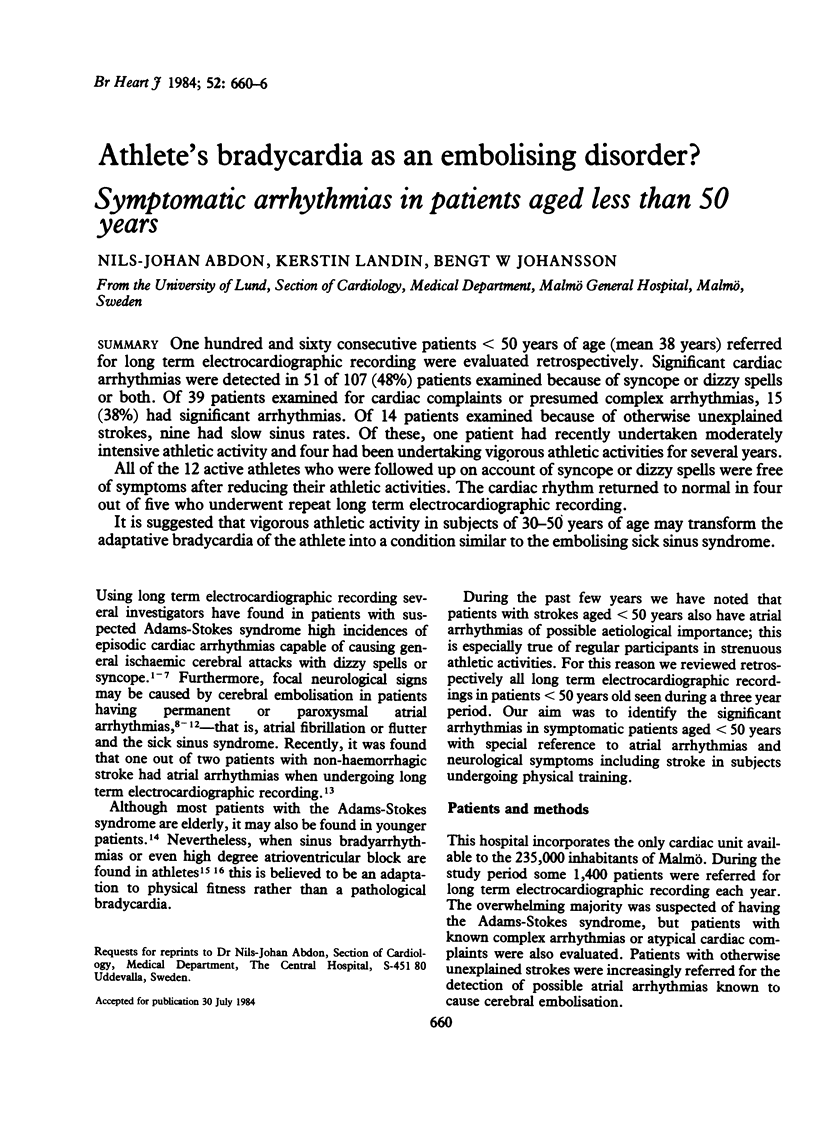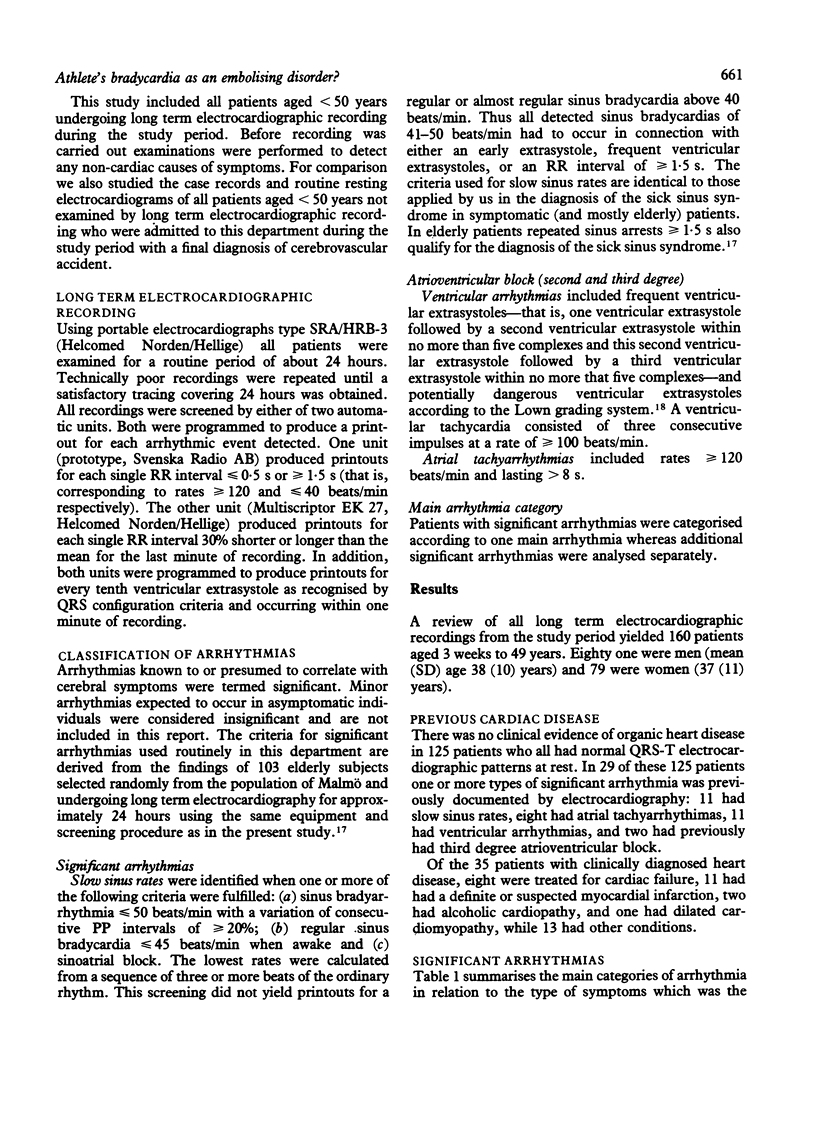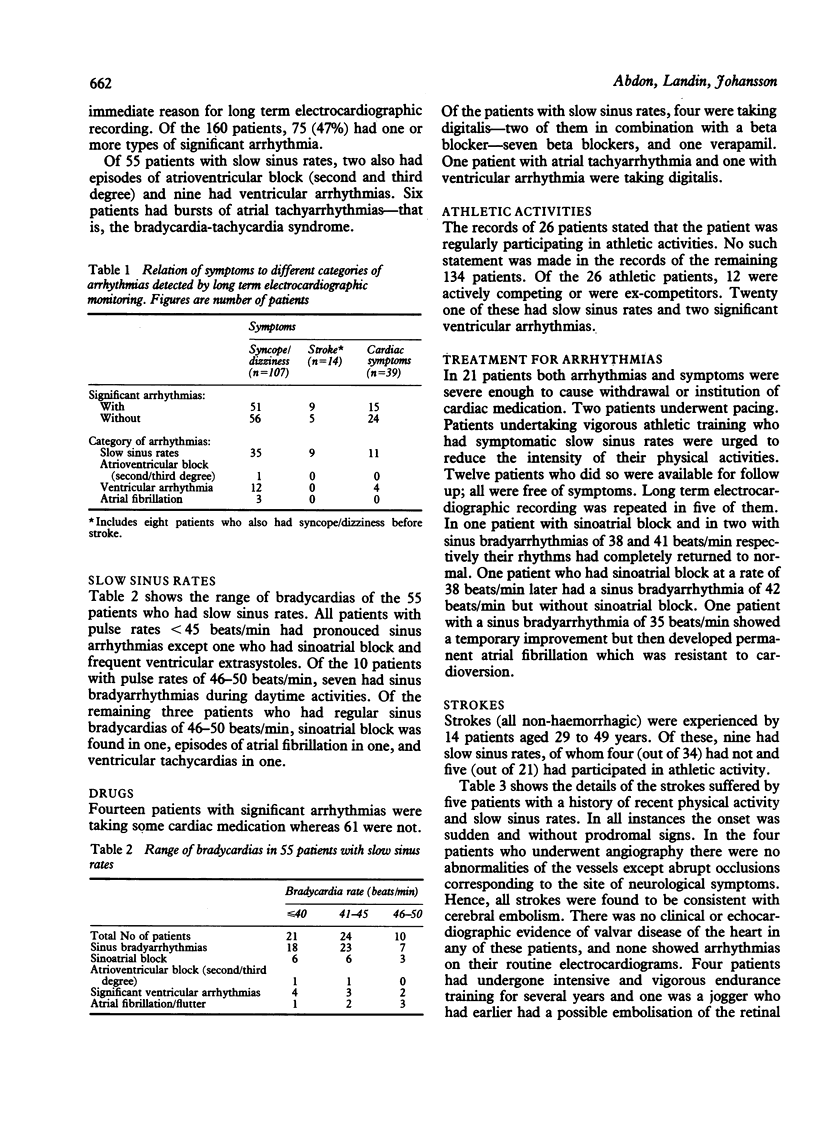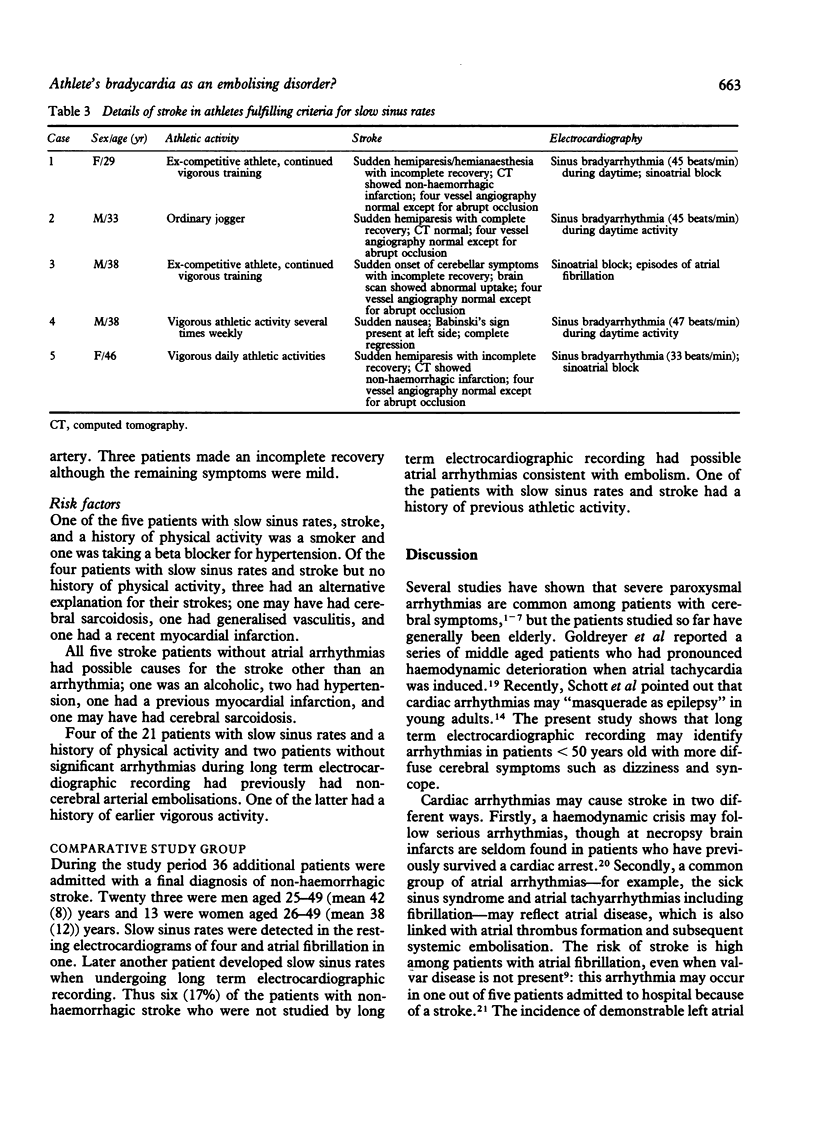Abstract
One hundred and sixty consecutive patients less than 50 years of age (mean 38 years) referred for long term electrocardiographic recording were evaluated retrospectively. Significant cardiac arrhythmias were detected in 51 of 107 (48%) patients examined because of syncope or dizzy spells or both. Of 39 patients examined for cardiac complaints or presumed complex arrhythmias, 15 (38%) had significant arrhythmias. Of 14 patients examined because of otherwise unexplained strokes, nine had slow sinus rates. Of these, one patient had recently undertaken moderately intensive athletic activity and four had been undertaking vigorous athletic activities for several years. All of the 12 active athletes who were followed up on account of syncope or dizzy spells were free of symptoms after reducing their athletic activities. The cardiac rhythm returned to normal in four out of five who underwent repeat long term electrocardiographic recording. It is suggested that vigorous athletic activity in subjects of 30-50 years of age may transform the adaptative bradycardia of the athlete into a condition similar to the embolising sick sinus syndrome.
Full text
PDF






Selected References
These references are in PubMed. This may not be the complete list of references from this article.
- Abdon N. J. Frequency and distribution of long-term ECG-recorded cardiac arrhythmias in an elderly population. With special reference to neurological symptoms. Acta Med Scand. 1981;209(3):175–183. doi: 10.1111/j.0954-6820.1981.tb11573.x. [DOI] [PubMed] [Google Scholar]
- Abdon N. J., Zettervall O., Carlson J., Berglund S., Sterner G., Tejler L., Turesson I. Is occult atrial disorder a frequent cause of non-hemorrhagic stroke? Long-term ECG in 86 patients. Stroke. 1982 Nov-Dec;13(6):832–837. doi: 10.1161/01.str.13.6.832. [DOI] [PubMed] [Google Scholar]
- Adey H., Ballantyne D. A., Bostock M. I., Fleischl P., Kurta A. V., Langley R. B., McPherson I. G., Turner A. S. The prevalence of disturbance of cardiac rhythm in healthy New Zealand Adults: a pilot study. N Z Med J. 1978 Dec 13;88(625):433–435. [PubMed] [Google Scholar]
- Bathen J., Sparr S., Rokseth R. Embolism in sinoatrial disease. Acta Med Scand. 1978;203(1-2):7–11. doi: 10.1111/j.0954-6820.1978.tb14823.x. [DOI] [PubMed] [Google Scholar]
- Bathen J., Sparr S., Rokseth R. Embolism in sinoatrial disease. Acta Med Scand. 1978;203(1-2):7–11. doi: 10.1111/j.0954-6820.1978.tb14823.x. [DOI] [PubMed] [Google Scholar]
- Britton M., de Faire U., Helmers C., Miah K., Ryding C., Wester P. O. Arrhythmias in patients with acute cerebrovascular disease. Acta Med Scand. 1979;205(5):425–428. doi: 10.1111/j.0954-6820.1979.tb06076.x. [DOI] [PubMed] [Google Scholar]
- Brodsky M., Wu D., Denes P., Kanakis C., Rosen K. M. Arrhythmias documented by 24 hour continuous electrocardiographic monitoring in 50 male medical students without apparent heart disease. Am J Cardiol. 1977 Mar;39(3):390–395. doi: 10.1016/s0002-9149(77)80094-5. [DOI] [PubMed] [Google Scholar]
- Clarke J. M., Hamer J., Shelton J. R., Taylor S., Venning G. R. The rhythm of the normal human heart. Lancet. 1976 Sep 4;1(7984):508–512. doi: 10.1016/s0140-6736(76)90801-1. [DOI] [PubMed] [Google Scholar]
- Davies M. J., Pomerance A. Pathology of atrial fibrillation in man. Br Heart J. 1972 May;34(5):520–525. doi: 10.1136/hrt.34.5.520. [DOI] [PMC free article] [PubMed] [Google Scholar]
- Dietz A., Kirchhoff H. W. Die Variationsbreite von Herzrhythmusstörungen bei Herzgesunden. Z Kardiol. 1973 Apr;62(4):289–303. [PubMed] [Google Scholar]
- Djiane P., Egré A., Bory A., Savin B., Mostefa S., Serradimigni A. L'enregistrement électrocardiographique chez les sujets normaux. Arch Mal Coeur Vaiss. 1979 Jun;72(6):655–661. [PubMed] [Google Scholar]
- Engel U. R., Burckhardt D. Häufigkeit und Art von Herzrhythmusstörungen sowie Ekg.-Veränderungen bei jugendlichen herzgesunden Probanden Untersuchung mit dem Langzeitüberwachungs-Elektrokardiogramm. Schweiz Med Wochenschr. 1975 Nov 1;105(44):1467–1469. [PubMed] [Google Scholar]
- Fairfax A. J., Lambert C. D., Leatham A. Systemic embolism in chronic sinoatrial disorder. N Engl J Med. 1976 Jul 22;295(4):190–192. doi: 10.1056/NEJM197607222950403. [DOI] [PubMed] [Google Scholar]
- Fairfax A. J., Lambert C. D., Leatham A. Systemic embolism in chronic sinoatrial disorder. N Engl J Med. 1976 Jul 22;295(4):190–192. doi: 10.1056/NEJM197607222950403. [DOI] [PubMed] [Google Scholar]
- Goldberg A. D., Raftery E. B., Cashman P. M. Ambulatory electrocardiographic records in patients with transient cerebral attacks or palpitation. Br Med J. 1975 Dec 6;4(5996):569–571. doi: 10.1136/bmj.4.5996.569. [DOI] [PMC free article] [PubMed] [Google Scholar]
- Goldreyer B. N., Kastor J. A., Kershbaum K. L. The hemodynamic effects of induced supraventricular tachycardia in man. Circulation. 1976 Nov;54(5):783–789. doi: 10.1161/01.cir.54.5.783. [DOI] [PubMed] [Google Scholar]
- Hanne-Paparo N., Drory Y., Schoenfeld Y., Shapira Y., Kellermann J. J. Common ECG changes in athletes. Cardiology. 1976;61(4):267–278. doi: 10.1159/000169770. [DOI] [PubMed] [Google Scholar]
- Hinton R. C., Kistler J. P., Fallon J. T., Friedlich A. L., Fisher C. M. Influence of etiology of atrial fibrillation on incidence of systemic embolism. Am J Cardiol. 1977 Oct;40(4):509–513. doi: 10.1016/0002-9149(77)90064-9. [DOI] [PubMed] [Google Scholar]
- Johansson B. W. Long-term ECG in ambulatory clinical practice. Analysis and 2-year follow-up of 100 patients studied with a portable ECG tape recorder. Eur J Cardiol. 1977 Jan;5(1):39–48. [PubMed] [Google Scholar]
- Jonas S., Klein I., Dimant J. Importance of Holter monitoring in patients with periodic cerebral symptoms. Ann Neurol. 1977 May;1(5):470–474. doi: 10.1002/ana.410010511. [DOI] [PubMed] [Google Scholar]
- Kerr C. R., Strauss H. C. The measurement of sinus node refractoriness in man. Circulation. 1983 Dec;68(6):1231–1237. doi: 10.1161/01.cir.68.6.1231. [DOI] [PubMed] [Google Scholar]
- Lichtman J., O'Rourke R. A., Klein A., Karliner J. S. Electrocardiogram of the athlete. Alterations simulating those of organic heart disease. Arch Intern Med. 1973 Nov;132(5):763–770. [PubMed] [Google Scholar]
- Lipski J., Cohen L., Espinoza J., Motro M., Dack S., Donoso E. Value of Holter monitoring in assessing cardiac arrhythmias in symptomatic patients. Am J Cardiol. 1976 Jan;37(1):102–107. doi: 10.1016/0002-9149(76)90507-5. [DOI] [PubMed] [Google Scholar]
- Lown B., Wolf M. Approaches to sudden death from coronary heart disease. Circulation. 1971 Jul;44(1):130–142. doi: 10.1161/01.cir.44.1.130. [DOI] [PubMed] [Google Scholar]
- Mackintosh A. F. Sinuatrial disease in young people. Br Heart J. 1981 Jan;45(1):62–66. doi: 10.1136/hrt.45.1.62. [DOI] [PMC free article] [PubMed] [Google Scholar]
- Raftery E. B., Cashman P. M. Long-term recording of the electrocardiogram in a normal population. Postgrad Med J. 1976;52 (Suppl 7):32–38. [PubMed] [Google Scholar]
- Rasmussen V., Haunsø S., Skagen K. Cerebral attacks due to excessive vagal tone in heavily trained persons. A clinical and electrophysiologic study. Acta Med Scand. 1978;204(5):401–405. doi: 10.1111/j.0954-6820.1978.tb08462.x. [DOI] [PubMed] [Google Scholar]
- Rubenstein J. J., Schulman C. L., Yurchak P. M., DeSanctis R. W. Clinical spectrum of the sick sinus syndrome. Circulation. 1972 Jul;46(1):5–13. doi: 10.1161/01.cir.46.1.5. [DOI] [PubMed] [Google Scholar]
- Schott G. D., McLeod A. A., Jewitt D. E. Cardiac arrhythmias that masquerade as epilepsy. Br Med J. 1977 Jun 4;1(6074):1454–1457. doi: 10.1136/bmj.1.6074.1454. [DOI] [PMC free article] [PubMed] [Google Scholar]
- Sobotka P. A., Mayer J. H., Bauernfeind R. A., Kanakis C., Jr, Rosen K. M. Arrhythmias documented by 24-hour continuous ambulatory electrocardiographic monitoring in young women without apparent heart disease. Am Heart J. 1981 Jun;101(6):753–759. doi: 10.1016/0002-8703(81)90611-6. [DOI] [PubMed] [Google Scholar]
- Stern S., Ben-Shachar G., Tzivoni D., Braun K. Detection of transient arrhythmias by continuous long-term recording of electrocardiograms of active subjects. Isr J Med Sci. 1970 Jan-Feb;6(1):103–112. [PubMed] [Google Scholar]
- Torvik A., Skullerud K. How often are brain infarcts caused by hypotensive episodes? Stroke. 1976 May-Jun;7(3):255–257. doi: 10.1161/01.str.7.3.255. [DOI] [PubMed] [Google Scholar]
- Van Durme J. P. Tachyarrhythmias and transient cerebral ischemic attacks. Am Heart J. 1975 Apr;89(4):538–540. doi: 10.1016/0002-8703(75)90164-7. [DOI] [PubMed] [Google Scholar]
- Viitasalo M. T., Kala R., Eisalo A. Ambulatory electrocardiographic recording in endurance athletes. Br Heart J. 1982 Mar;47(3):213–220. doi: 10.1136/hrt.47.3.213. [DOI] [PMC free article] [PubMed] [Google Scholar]
- Walter P. F., Reid S. D., Jr, Wenger N. K. Transient cerebral ischemia due to arrhythmia. Ann Intern Med. 1970 Apr;72(4):471–474. doi: 10.7326/0003-4819-72-4-471. [DOI] [PubMed] [Google Scholar]
- Zapfe H., Hatano Y. Veränderungen in Ekg gesunder Erwachsener während des Tagesablaufes. Z Kreislaufforsch. 1967 Apr;56(4):411–423. [PubMed] [Google Scholar]


